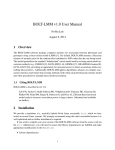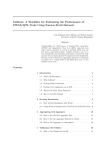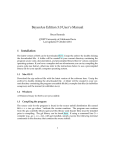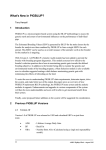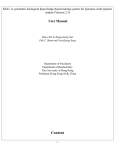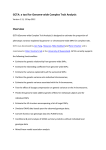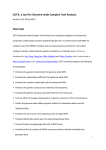Download BOLT-LMM v2.0 User Manual
Transcript
BOLT-LMM v2.0 User Manual
Po-Ru Loh
March 13, 2015
Contents
1
Overview
1.1 BOLT-LMM mixed model association testing . . . . . . . . . . . . . . . . . . . .
1.2 BOLT-REML variance components analysis . . . . . . . . . . . . . . . . . . . . .
2
2
3
2
Installation
2.1 Running BOLT-LMM and BOLT-REML . . . . . . . . . . . . . . . . . . . . . . .
2.2 Examples . . . . . . . . . . . . . . . . . . . . . . . . . . . . . . . . . . . . . . .
2.3 Help . . . . . . . . . . . . . . . . . . . . . . . . . . . . . . . . . . . . . . . . . .
3
4
4
4
3
Computing requirements
3.1 Operating system . . .
3.2 Memory . . . . . . . .
3.3 Running time . . . . .
3.3.1 Multi-threading
.
.
.
.
5
5
5
5
5
4
Input/output file naming conventions
4.1 Automatic gzip [de]compression . . . . . . . . . . . . . . . . . . . . . . . . . . .
4.2 Arrays of input files and covariates . . . . . . . . . . . . . . . . . . . . . . . . . .
5
5
6
5
Input
5.1 Genotypes . . . . . . . . . . . .
5.1.1 Reference genetic maps
5.1.2 Imputed SNP dosages .
5.2 Phenotypes . . . . . . . . . . .
5.3 Covariates . . . . . . . . . . . .
5.4 Missing data treatment . . . . .
5.5 Genotype QC . . . . . . . . . .
5.6 User-specified filters . . . . . .
6
6
6
6
8
8
9
9
9
.
.
.
.
.
.
.
.
.
.
.
.
.
.
.
.
.
.
.
.
.
.
.
.
.
.
.
.
.
.
.
.
.
.
.
.
.
.
.
.
.
.
.
.
.
.
.
.
.
.
.
.
.
.
.
.
.
.
.
.
.
.
.
.
.
.
.
.
1
.
.
.
.
.
.
.
.
.
.
.
.
.
.
.
.
.
.
.
.
.
.
.
.
.
.
.
.
.
.
.
.
.
.
.
.
.
.
.
.
.
.
.
.
.
.
.
.
.
.
.
.
.
.
.
.
.
.
.
.
.
.
.
.
.
.
.
.
.
.
.
.
.
.
.
.
.
.
.
.
.
.
.
.
.
.
.
.
.
.
.
.
.
.
.
.
.
.
.
.
.
.
.
.
.
.
.
.
.
.
.
.
.
.
.
.
.
.
.
.
.
.
.
.
.
.
.
.
.
.
.
.
.
.
.
.
.
.
.
.
.
.
.
.
.
.
.
.
.
.
.
.
.
.
.
.
.
.
.
.
.
.
.
.
.
.
.
.
.
.
.
.
.
.
.
.
.
.
.
.
.
.
.
.
.
.
.
.
.
.
.
.
.
.
.
.
.
.
.
.
.
.
.
.
.
.
.
.
.
.
.
.
.
.
.
.
.
.
.
.
.
.
.
.
.
.
.
.
.
.
.
.
.
.
.
.
.
.
.
.
.
.
.
.
.
.
.
.
.
.
.
.
.
.
.
.
.
.
.
.
.
.
.
.
.
.
.
.
.
.
.
.
6
7
Association analysis (BOLT-LMM)
6.1 Mixed model association tests . . . . . . . . . .
6.2 BOLT-LMM mixed model association options . .
6.2.1 Restricting SNPs used in the mixed model
6.3 Standard linear regression . . . . . . . . . . . . .
.
.
.
.
.
.
.
.
.
.
.
.
.
.
.
.
.
.
.
.
.
.
.
.
.
.
.
.
.
.
.
.
.
.
.
.
.
.
.
.
.
.
.
.
.
.
.
.
.
.
.
.
.
.
.
.
.
.
.
.
.
.
.
.
.
.
.
.
9
. 9
. 10
. 10
. 10
Variance components analysis (BOLT-REML)
7.1 Multiple variance components . . . . . . .
7.2 Multiple traits . . . . . . . . . . . . . . . .
7.3 Initial variance parameter guesses . . . . .
7.4 Trading a little accuracy for speed . . . . .
.
.
.
.
.
.
.
.
.
.
.
.
.
.
.
.
.
.
.
.
.
.
.
.
.
.
.
.
.
.
.
.
.
.
.
.
.
.
.
.
.
.
.
.
.
.
.
.
.
.
.
.
.
.
.
.
.
.
.
.
.
.
.
.
.
.
.
.
.
.
.
.
.
.
.
.
.
.
.
.
.
.
.
.
10
11
11
11
11
8
Output
12
8.1 BOLT-LMM association test statistics . . . . . . . . . . . . . . . . . . . . . . . . 12
8.2 BOLT-REML output and logging . . . . . . . . . . . . . . . . . . . . . . . . . . . 12
9
Change log
13
10 Website and contact info
13
11 License
13
1
Overview
The BOLT-LMM software package currently consists of two main algorithms, the BOLT-LMM
algorithm for mixed model association testing, and the BOLT-REML algorithm for variance components analysis (i.e., partitioning of SNP-heritability and estimation of genetic correlations).
1.1
BOLT-LMM mixed model association testing
The BOLT-LMM algorithm computes statistics for testing association between phenotype and
genotypes using a linear mixed model (LMM) [1]. By default, BOLT-LMM assumes a Bayesian
mixture-of-normals prior for the random effect attributed to SNPs other than the one being tested.
This model generalizes the standard “infinitesimal” mixed model used by existing mixed model association methods (e.g., EMMAX [2], FaST-LMM [3–6], GEMMA [7], GRAMMAR-Gamma [8],
GCTA-LOCO [9]), providing an opportunity for increased power to detect associations while controlling false positives. Additionally, BOLT-LMM applies algorithmic advances to compute mixed
model association statistics much faster than existing methods, both when using the Bayesian mixture model and when specialized to standard mixed model association. BOLT-LMM is described
in ref. [1]:
Loh P-R, Tucker G, Bulik-Sullivan BK, Vilhjálmsson BJ, Finucane HK, Salem RM,
Chasman DI, Ridker PM, Neale BM, Berger B, Patterson N, and Price AL. Efficient
2
Bayesian mixed model analysis increases association power in large cohorts. Nature
Genetics, 2015.
1.2
BOLT-REML variance components analysis
The BOLT-REML algorithm estimates heritability explained by genotyped SNPs and genetic correlations among multiple traits measured on the same set of individuals. Like the GCTA software [10], BOLT-REML applies variance components analysis to perform these tasks, supporting
both multi-component modeling to partition SNP-heritability and multi-trait modeling to estimate
correlations. BOLT-REML applies a Monte Carlo algorithm that is much faster than standard
methods for variance components analysis (e.g., GCTA) at large sample sizes. BOLT-REML is
described in ref. [11]:
Loh P-R, Bhatia G, Gusev A, Finucane HK, Bulik-Sullivan BK, Pollack SJ, PGCSCZ Working Group, de Candia TR, Lee SH, Wray NR, Kendler KS, O’Donovan
MC, Neale BM, Patterson N, and Price AL. Contrasting regional architectures of
schizophrenia and other complex diseases using fast variance components analysis.
bioRxiv, 2015.
2
Installation
We provide a standalone (i.e., statically linked) 64-bit Linux executable, bolt, which we have
tested on several Linux systems. We strongly recommend using this static executable because it is
well-optimized and no further installation is required.
If you wish to compile your own version of the BOLT-LMM software from the source code (in
the src/ subdirectory, provided in a separate download licensed under GNU GPLv3), you will
need to ensure that library dependencies are fulfilled and will need to make appropriate modifications to the Makefile:
• Library dependencies:
– BLAS/LAPACK numerical libraries. The speed of the BOLT-LMM software depends
critically on the efficiency of the BLAS/LAPACK implementation it is linked against.
We recommend the Intel Math Kernel Library (MKL) if available; otherwise, ATLAS
may be a good alternative.
– Boost C++ libraries. BOLT-LMM links against the Boost program_options and
iostreams libraries, which need to be installed after downloading and unzipping
Boost.
– NLopt numerical optimization library [12].
• Makefile: Paths to libraries need to be modified appropriately. Note that the released version of the Makefile does not set the flag -DUSE_MKL_MALLOC. This flag turns on the
Intel MKL’s fast memory manager (replacing calls to _mm_malloc with mkl_malloc),
3
which may improve memory performance, but we have observed crashes on some systems
when using mkl_malloc.
For reference, the provided bolt executable was created on the Harvard Medical School “Orchestra” research computing cluster using Intel Composer XE 12.0.5 (MKL 10.3.5) and the Boost 1.42
and NLopt 2.4.2 libraries by invoking make cluster=orchestra linking=static.
2.1
Running BOLT-LMM and BOLT-REML
To run the bolt executable, simply invoke ./bolt on the Linux command line (within the
BOLT-LMM install directory) with parameters in the format --optionName=optionValue.
2.2
Examples
The example/ subdirectory contains a bash script run_example.sh that demonstrates basic
use of BOLT-LMM on a small example data set. Likewise, run_example_reml2.sh demonstrates BOLT-REML.
• A minimal BOLT-LMM invocation looks like:
./bolt --bfile=geno --phenoFile=pheno.txt --phenoCol=phenoN ame
--lmm --LDscoresFile=tables/LDSCORE.1000G_EUR.tab.gz
--statsFile=stats.tab
• A minimal BOLT-REML invocation looks like:
./bolt --bfile=geno --phenoFile=pheno.txt --phenoCol=phenoN ame
--reml --modelSnps=modelSnps.txt
To perform multi-trait BOLT-REML (i.e., estimate genetic correlations), provide multiple
--phenoCol=phenoN arguments.
2.3
Help
To get a list of basic options, run:
./bolt -h
To get a complete list of basic and advanced options, run:
./bolt --helpFull
4
3
Computing requirements
3.1
Operating system
At the current time we have only compiled and tested BOLT-LMM on Linux computing environments; however, the source code is available if you wish to try compiling BOLT-LMM for a
different operating system.
3.2
Memory
For typical data sets (M, N > 10,000), BOLT-LMM and BOLT-REML use approximately MN/4
bytes of memory, where M is the number of SNPs and N is the number of individuals. More
precisely:
• M = # of SNPs in bim file(s) that satisfy all of the conditions:
– not listed in any --exclude file
– passed QC filter for missingness
– listed in --modelSnps file(s), if specified
• N = # of individuals in fam file and not listed in any --remove file (but pre-QC; i.e., N
includes individuals filtered due to missing genotypes or covariates)
3.3
Running time
In practice, BOLT-LMM and BOLT-REML have running times that scale roughly with MN1.5 . Our
largest analyses of real data (M = 600K SNPs, N = 60K individuals) took ≈1 day using a single
computational core. We have also tested BOLT-LMM on simulated data sets containing up to N =
480K individuals; for more details, please see the BOLT-LMM manuscript [1].
3.3.1
Multi-threading
On multi-core machines, running time can be reduced by invoking multi-threading using the
--numThreads option.
4
4.1
Input/output file naming conventions
Automatic gzip [de]compression
The BOLT-LMM software assumes that input files ending in .gz are gzip-compressed and automatically decompresses them on-the-fly (i.e., without creating a temporary file). Similarly, BOLTLMM writes gzip-compressed output to any output file ending in .gz.
5
4.2
Arrays of input files and covariates
Arrays of sequentially-numbered input files and covariates can be specified by the shorthand
{i:j}. For example,
data.chr{1:22}.bim
is interpreted as the list of files
data.chr1.bim, data.chr2.bim, ..., data.chr22.bim
5
5.1
Input
Genotypes
The BOLT-LMM software takes genotype input in PLINK [13] binary format (bed/bim/fam).
For file conversion and data manipulation in general, we highly recommend the PLINK2 software [14], which is providing a comprehensive, much more efficient update to PLINK.
If all genotypes are contained in a single bed/bim/fam file triple with the same file prefix,
you may simply use the command line option --bfile=prefix. Genotypes may also be split
into multiple bed and bim files containing consecutive sets of SNPs (e.g., one bed/bim file pair
per chromosome) either by using multiple --bed and --bim invocations or by using the file
array shorthand described above (e.g., --bim=data.chr{1:22}.bim).
5.1.1
Reference genetic maps
The BOLT-LMM package includes reference maps that you can use to interpolate genetic map
coordinates from SNP physical (base pair) positions in the event that your PLINK bim file does
not contain genetic coordinates (in units of morgans). (The BOLT-LMM association testing algorithm uses genetic positions to prevent proximal contamination; BOLT-REML does not use this
information.) To use a reference map, use the option
--geneticMapFile=tables/genetic_map_hg##.txt.gz
selecting the build (hg17, hg18, or hg19) corresponding to the physical coordinates of your bim
file. You may use the --geneticMapFile option even if your PLINK bim file does contain
genetic coordinates; in this case, the genetic coordinates in the bim file will be ignored, and
interpolated coordinates will be used instead.
5.1.2
Imputed SNP dosages
As of version 1.1, the BOLT-LMM association testing algorithm supports computation of mixed
model association statistics at an arbitrary number of imputed SNPs (with real-valued “dosages”
rather than hard-called genotypes) using a mixed model built on a subset of hard-called genotypes.
(BOLT-REML variance components analysis does not support dosage input.) This approach requires only a trivial amount of additional computation and no additional RAM, as it simply applies
6
a genome scan (as in GRAMMAR-Gamma [8]) of real-valued dosage SNPs against the residual
phenotypes that BOLT-LMM already computes. We expect that using a mixed model built on only
a subset of ≈500K hard-called genotypes should sacrifice almost no power while retaining the
computational efficiency of BOLT-LMM.
If you have only imputed SNP data on hand, you will need to pre-process your data set to
create a subset of hard-called SNPs in PLINK format for BOLT-LMM. We suggest the following
procedure.
1. Determine a high-confidence set of SNPs (e.g., based on IMPUTE2 INFO score) at which
to create an initial hard-call set.
2. Create hard-called genotypes at these SNPs in PLINK format.
3. Use PLINK to LD prune to ≈500K SNPs (via --indep-pairwise 50 5 r2thresh for
an appropriate r2thresh).
4. Run BOLT-LMM using the final hard-called SNPs as the --bfile (or bed/bim/fam)
argument, specifying the imputed SNPs as additional association test SNPs using one of the
formats below.
Imputed SNPs in dosage format. This input format consists of one or more --dosageFile
parameters specifying files that contain real-valued genotype expectations at imputed SNPs. Each
line of a --dosageFile should be formatted as follows:
rsID
chr
pos
allele1
allele0
[dosage = E[#allele1]] x N
Missing (i.e., uncalled) dosages can be specified with –9. You will also need to provide one
additional --dosageFidIidFile specifying the PLINK FIDs and IIDs of samples that the
dosages correspond to. See the example/ subdirectory for an example.
Imputed SNPs in IMPUTE2 format. You may also specify imputed SNPs as output by the
IMPUTE2 software [15]. The IMPUTE2 genotype file format is as follows:
snpID
rsID
pos
allele1
allele0
[p(11) p(10) p(00)] x N
(BOLT-LMM ignores the snpID field.) Here, instead of dosages, each genotype entry contains individual probabilities of the individual being homozygous for allele1, heterozygous, and homozygous for allele0. The three probabilities need not sum to 1, allowing for genotype uncertainty; if
the sum of the probabilities is less than the --impute2CallThresh parameter, BOLT-LMM
treats the genotype as missing.
To compute association statistics at a list of files containing IMPUTE2 SNPs, you may list
the files within a --impute2FileList file. Each line of this file should contain two entries:
a chromosome number followed by an IMPUTE2 genotype file containing SNPs from that chromosome. You will also need to provide one additional --impute2FidIidFile specifying the
PLINK FIDs and IIDs of samples that the IMPUTE2 genotypes correspond to. See the example/
subdirectory for an example.
7
Imputed SNPs in 2-dosage format. You may also specify imputed SNPs as output by the Ricopili pipeline and plink2 --dosage format=2. This file format consists of file pairs: (1)
PLINK map files containing information about SNP locations; and (2) genotype probability files
in the 2-dosage format, which consists of a header line
SNP
A1
A2
[FID IID] x N
followed by one line per SNP in the format
rsID
allele1
allele0
[p(11) p(10)] x N
The third genotype probability for each entry is assumed to be p(00)=1-p(11)-p(10) (unlike
with the IMPUTE2 format).
To compute association statistics at SNPs in a list of 2-dosage files, you may list the files within
a --dosage2FileList file. Each line of this file should contain two entries: a PLINK map file
followed by the corresponding genotype file containing probabilities for those SNPs. (As usual, if
either file ends with .gz, it is automatically unzipped; otherwise it is assumed to be plain text.)
See the example/ subdirectory for an example.
5.2
Phenotypes
Phenotypes may be specified in either of two ways:
• --phenoUseFam: This option tells BOLT-LMM and BOLT-REML to use the last (6th)
column of the fam file as the phenotypes. This column must be numeric, so case-control
phenotypes should be 0,1 coded and missing values should be indicated with -9.
• --phenoFile and --phenoCol: Alternatively, phenotypes may be provided in a separate whitespace-delimited file (specified with --phenoFile) with the first line containing column headers and subsequent lines containing records, one per individual. The first
two columns must be FID and IID (the PLINK identifiers of an individual). Any number
of columns may follow; the column containing the phenotype to analyze is specified with
--phenoCol. Values of -9 and -NA are interpreted as missing data. All other values in
the column should be numeric. The records in lines following the header line need not be in
sorted order and need not match the individuals in the genotype data (i.e., fam file); BOLTLMM and BOLT-REML will analyze only the individuals in the intersection of the genotype
and phenotype files and will output a warning if these sets do not match.
5.3
Covariates
Covariate data may be specified in a file (--covarFile) with the same format as the alternate
phenotype file described above. (The same file may be used for both phenotypes and covariates.) Each covariate to be used must be specified using either a --covarCol (for categorical
covariates) or a --qCovarCol (for quantitative covariates) option. Categorical covariate values
are allowed to be any text strings not containing whitespace; each unique text string in a column
8
corresponds to a category. Quantitative covariate values must be numeric (with the exception of
NA). In either case, values of -9 and -NA are interpreted as missing data. If groups of covariates
of the same type are numbered sequentially, they may be specified using array shorthand (e.g.,
--qCovarCol=PC{1:10} for columns PC1, PC2, ..., PC10).
5.4
Missing data treatment
Individuals with missing phenotypes are ignored. By default, individuals with any missing covariates are also ignored; this approach is commonly used and referred to as “complete case
analysis.” As an alternative, we have also implemented the “missing indicator method” (via the
--covarUseMissingIndic option), which adds indicator variables demarcating missing status as additional covariates. Missing genotypes are replaced with per-SNP averages.
5.5
Genotype QC
BOLT-LMM and BOLT-REML automatically filter SNPs and individuals with missing rates exceeding thresholds of 0.1. These thresholds may be modified using --maxMissingPerSnp and
--maxMissingPerIndiv. Note that filtering is not performed based on minor allele frequency
or deviation from Hardy-Weinberg equilibrium. Allele frequency and missingness of each SNP are
included in the BOLT-LMM association test output, however, and we recommend checking these
values and Hardy-Weinberg p-values (which are easily computed using PLINK2 --hardy) when
following up on significant associations.
5.6
User-specified filters
Individuals to remove from the analysis may be specified in one or more --remove files listing
FID and IIDs (one individual per line). Similarly, SNPs to exclude from the analysis may be
specified in one ore more --exclude files listing SNP IDs (typically rs numbers).
6
Association analysis (BOLT-LMM)
6.1
Mixed model association tests
BOLT-LMM computes two association statistics, χ2 BOLT-LMM and χ2 BOLT-LMM-inf , described in detail
in our manuscript [1].
• BOLT-LMM: Association test on residuals from Bayesian modeling using a mixtureof-normals prior on SNP effect sizes. This approach can fit “non-infinitesimal” traits with
loci having moderate to large effects, allowing increased association power.
• BOLT-LMM-inf: Standard (infinitesimal) mixed model association. This statistic approximates the standard approach used by existing software.
9
6.2
BOLT-LMM mixed model association options
The BOLT-LMM software offers the following options for mixed model analysis:
• --lmm: Performs default BOLT-LMM analysis, which consists of (1a) estimating heritability parameters, (1b) computing the BOLT-LMM-inf statistic, (2a) estimating Gaussian mixture parameters, and (2b) computing the BOLT-LMM statistic only if an increase in power
is expected. If BOLT-LMM determines based on cross-validation that the non-infinitesimal
model is likely to yield no increase in power, the BOLT-LMM (Bayesian) mixed model
statistic is not computed.
• --lmmInfOnly: Computes only infinitesimal mixed model association statistics (i.e.,
steps 1a and 1b).
• --lmmForceNonInf: Computes both the BOLT-LMM-inf and BOLT-LMM statistics regardless of whether or not an increase in power is expected from the latter.
6.2.1
Restricting SNPs used in the mixed model
If millions of SNPs are available from imputation, we suggest including ≤1 million SNPs at a
time in the mixed model (using the --modelSnps option) when performing association analysis. Using an LD pruned set of ≤1 million SNPs should achieve near-optimal power and correction
for confounding while reducing computational cost and improving convergence. Note that even
when a file of --modelSnps is specified, all SNPs in the genotype data are still tested for association; only the random effects in the mixed model are restricted to the --modelSnps. Also
note that BOLT-LMM automatically performs leave-one-chromosome-out (LOCO) analysis, leaving out SNPs from the chromosome containing the SNP being tested in order to avoid proximal
contamination [4, 9].
6.3
Standard linear regression
Setting the --verboseStats flag will output standard linear regression chi-square statistics and
p-values in additional output columns CHISQ_LINREG and P_LINREG. Note that unlike mixed
model association, linear regression is susceptible to population stratification, so you may wish to
include principal components (computed using other software, e.g., PLINK2 or FastPCA [16] in
EIGENSOFT v6.0+) as covariates when performing linear regression.
7
Variance components analysis (BOLT-REML)
Using the --reml option invokes the BOLT-REML algorithm for estimating heritability parameters and genetic correlations.
10
7.1
Multiple variance components
To assign SNPs to different variance components, specify a --modelSnps file in which each
whitespace-delimited line contains a SNP ID (typically an rs number) followed by the name of the
variance component to which it belongs.
7.2
Multiple traits
To perform multi-trait variance components analysis, specify multiple --phenoCol parametervalue flags (corresponding to different columns in the same --phenoFile). BOLT-REML currently only supports multi-trait analysis of traits phenotyped on a single set of individuals, so any
individuals with at least one missing phenotype will be ignored. For D traits, BOLT-REML estimates D heritability parameters per variance component and D(D − 1)/2 correlations per variance
component (including the residual variance component).
7.3
Initial variance parameter guesses
To specify a set of variance parameters at which to start REML iteration (which may save time
compared to the default procedure used by BOLT-REML if you have good initial guesses), use
--remlGuessStr="string" with the following format. For each variance component (starting with the residual term, which is automatically named env/noise), specify the name of the
variance component followed by the initial guess. For instance, a model with two (non-residual)
variance components named vc1 and vc2 (in the --modelSnps file) could have variance parameter guesses specified by:
--remlGuessStr="env/noise 0.5 vc1 0.2 vc2 0.3"
Note that the sum of the estimates must equal 1; BOLT-REML will automatically normalize the
phenotype accordingly.
For multi-trait analysis of D traits, the --remlGuessStr needs to specify both guesses of
D variance proportions and D(D − 1)/2 pairwise correlations per variance component. Viewing
these values as entries of an upper-triangular matrix (with variance proportions on the diagonal and
correlations above the diagonal), you should specify these D(D + 1)/2 values after each variance
component name by reading them off left-to-right, top-to-bottom.
7.4
Trading a little accuracy for speed
BOLT-REML uses a Monte Carlo algorithm to increase REML optimization speed [11]. By default, BOLT-REML performs an initial optimization using 15 Monte Carlo trials and then refines
parameter estimates using 100 Monte Carlo trials. If computational cost is a concern (or to perform
exploratory analyses), you can skip the refinement step using the --remlNoRefine flag. This
option typically gives 2–3x speedup at the cost of ≈1.03x higher standard errors.
11
8
Output
8.1
BOLT-LMM association test statistics
BOLT-LMM association statistics are output in a tab-delimited --statsFile file with the following fields, one line per SNP:
• SNP: rs number or ID string
• CHR: chromosome
• BP: physical (base pair) position
• GENPOS: genetic position either from bim file or interpolated from genetic map
• ALLELE1: first allele in bim file (usually the minor allele), used as the effect allele
• ALLELE0: second allele in bim file, used as the reference allele
• A1FREQ: frequency of first allele
• F_MISS: fraction of individuals with missing genotype at this SNP
• BETA: effect size from BOLT-LMM approximation to infinitesimal mixed model
• SE: standard error of effect size
• P_BOLT_LMM_INF: infinitesimal mixed model association test p-value
• P_BOLT_LMM: non-infinitesimal mixed model association test p-value
Optional additional output. To output chi-square statistics for all association tests, set the
--verboseStats flag.
8.2
BOLT-REML output and logging
BOLT-REML output (i.e., variance parameter estimates and standard errors) is simply printed to
the terminal (stdout) when analysis finishes. Both BOLT-LMM and BOLT-REML write output
to (stdout and stderr) as analysis proceeds; we recommend saving this output. If you wish to
save this output while simultaneously viewing it on the command line, you may do so using
./bolt [... list of options ...] 2>&1 | tee output.log
12
9
Change log
• Version 2.0 (Mar 13, 2015): Added BOLT-REML algorithm for estimating heritability parameters. Fixed parameter-initialization bug that prevented BOLT-LMM from running on
some systems. Implemented various minor improvements to parameter-checking.
• (Dec 8, 2014): Licensed source code under GPLv3.
• Version 1.2 (Nov 4, 2014): Added support for testing imputed SNPs in 2-dosage format
(Ricopili/plink2 format=2). Fixed bug causing nan heritability estimates.
• Version 1.1 (Oct 17, 2014): Added support for testing imputed SNPs with probabilistic
dosages.
• Version 1.0 (Aug 8, 2014): Initial release.
10
Website and contact info
Software updates will be posted at the following website:
http://www.hsph.harvard.edu/alkes-price/software/
If you have comments or questions about the BOLT-LMM software, please contact Po-Ru Loh,
[email protected].
11
License
• The BOLT-LMM source code is free software under the GNU General Public License v3.0
(GPLv3).
• The BOLT-LMM executable is freely available but not open source because it was built with
the proprietary Intel Math Kernel Library (under a non-commercial license). Specific license
terms are as follows.
c
Copyright 2014
Harvard University. All rights reserved. This software is supplied without any warranty or guaranteed support whatsoever. Harvard University
cannot be responsible for its use, misuse, or functionality. The software may be
freely copied for non-commercial purposes provided this copyright notice is retained.
Starting from v2.0, the BOLT-REML component of the software also uses routines from the
NLopt library written by Steven G. Johnson and distributed under the MIT License (Copyc
right 2007-2011
Massachusetts Institute of Technology).
13
References
1. Loh, P.-R. et al. Efficient Bayesian mixed model analysis increases association power in
large cohorts. Nature Genetics (2015).
2. Kang, H. M. et al. Variance component model to account for sample structure in genomewide association studies. Nature Genetics 42, 348–354 (2010).
3. Lippert, C. et al. FaST linear mixed models for genome-wide association studies. Nature
Methods 8, 833–835 (2011).
4. Listgarten, J. et al. Improved linear mixed models for genome-wide association studies.
Nature Methods 9, 525–526 (2012).
5. Listgarten, J., Lippert, C. & Heckerman, D. FaST-LMM-Select for addressing confounding
from spatial structure and rare variants. Nature Genetics 45, 470–471 (2013).
6. Lippert, C. et al. The benefits of selecting phenotype-specific variants for applications of
mixed models in genomics. Scientific Reports 3 (2013).
7. Zhou, X. & Stephens, M. Genome-wide efficient mixed-model analysis for association
studies. Nature Genetics 44, 821–824 (2012).
8. Svishcheva, G. R., Axenovich, T. I., Belonogova, N. M., van Duijn, C. M. & Aulchenko,
Y. S. Rapid variance components-based method for whole-genome association analysis.
Nature Genetics (2012).
9. Yang, J., Zaitlen, N. A., Goddard, M. E., Visscher, P. M. & Price, A. L. Advantages and
pitfalls in the application of mixed-model association methods. Nature Genetics 46, 100–
106 (2014).
10. Yang, J., Lee, S. H., Goddard, M. E. & Visscher, P. M. GCTA: a tool for genome-wide
complex trait analysis. American Journal of Human Genetics 88, 76–82 (2011).
11. P-R, L. et al. Contrasting regional architectures of schizophrenia and other complex diseases
using fast variance components analysis. bioRxiv (2015).
12. Johnson, S. G. The NLopt nonlinear-optimization package. URL http://ab-initio.
mit.edu/nlopt.
13. Purcell, S. et al. PLINK: a tool set for whole-genome association and population-based
linkage analyses. American Journal of Human Genetics 81, 559–575 (2007).
14. Chang, C. C. et al. Second-generation PLINK: rising to the challenge of larger and richer
datasets. GigaScience (2015).
15. Howie, B. N., Donnelly, P. & Marchini, J. A flexible and accurate genotype imputation
method for the next generation of genome-wide association studies. PLoS Genetics 5,
e1000529 (2009).
14
16. Galinsky, K. J. et al. Fast PCA of very large samples in linear time. Abstract presented
at the 64th Annual Meeting of The American Society of Human Genetics, October 18–22,
2014, San Diego, CA.
15















